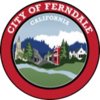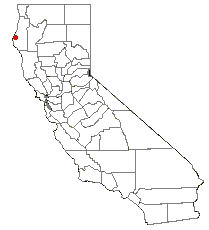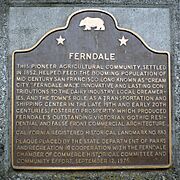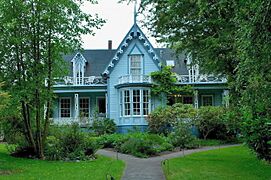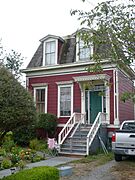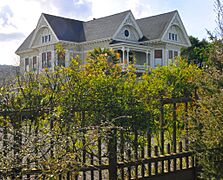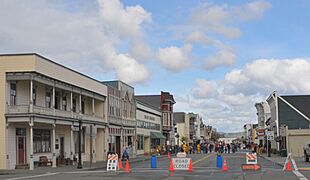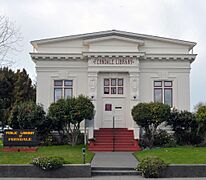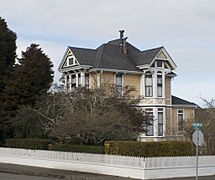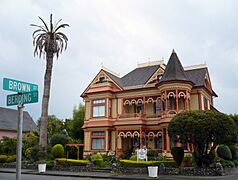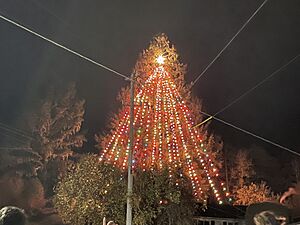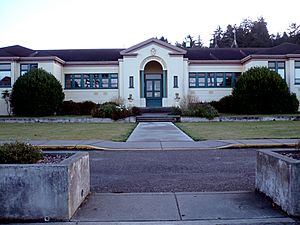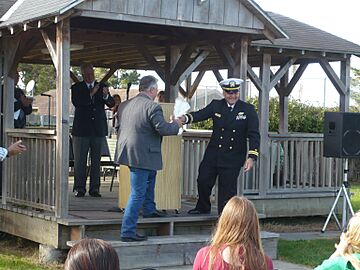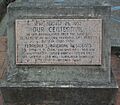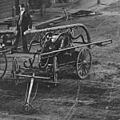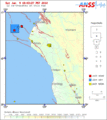Ferndale, California facts for kids
Quick facts for kids
Ferndale, California
|
||
|---|---|---|
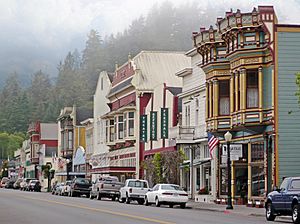
Main Street in Ferndale
|
||
|
||
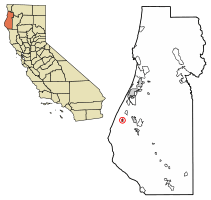
Location of Ferndale in Humboldt County, California
|
||
| Country | United States | |
| State | California | |
| County | Humboldt | |
| Incorporated | August 28, 1893 | |
| Government | ||
| • Type | Council–manager government | |
| Area | ||
| • Total | 1.03 sq mi (2.66 km2) | |
| • Land | 1.03 sq mi (2.66 km2) | |
| • Water | 0.00 sq mi (0.00 km2) 0% | |
| Elevation | 56 ft (17 m) | |
| Population
(2020)
|
||
| • Total | 1,398 | |
| • Density | 1,316.46/sq mi (508.29/km2) | |
| Time zone | UTC-8 (Pacific) | |
| • Summer (DST) | UTC-7 (PDT) | |
| ZIP Code |
95536
|
|
| Area code | 707 | |
| FIPS code | 06-23910 | |
| GNIS feature IDs | 277513, 2410497 | |
| Reference #: | 883 | |
Ferndale is a small city in Humboldt County, California, United States. In 2021, about 1,481 people lived there. The city is famous for its many well-preserved Victorian buildings. These include homes and storefronts.
Ferndale is often called the "northern gateway" to California's Lost Coast. It sits on a wide plain near the mouth of the Eel River. The city is also close to large forests of coast redwood trees.
Contents
History of Ferndale
Early Days and First Settlers
Before American settlers arrived, the Ferndale area was a giant field of ferns. These ferns grew taller than 6 feet! The land was surrounded by forests and swampy areas. The southern Wiyot people lived here. They fished for eels, salmon, and sturgeon in the Eel River. They also gathered shellfish and grew a type of tobacco.
The town of Ferndale was started in 1852. Willard Allard, Seth Louis Shaw, and his brother Stephen William Shaw were the first American settlers. They borrowed a canoe from the Wiyot people. They paddled up Francis Creek to the area where Main and Shaw streets are now. They cleared land and built a cabin. The settlement officially became a city in 1893.
Seth Shaw built the Gothic Revival style Shaw House in 1854. This house was very important. It served as the first place for voting in 1854. It also became the area's first post office and courthouse in 1863.
New Immigrants Arrive
Many different groups of people came to Ferndale. Early settlers were from Great Britain, New England, Canada, and Ireland. Later, immigrants arrived from Denmark, Switzerland, Germany, Italy, and Portugal.
Danish settlers built Our Savior's Lutheran Church in 1899. They also used Danish Hall for community events. Swiss families, both Italian-speaking and German-speaking, also settled here. The Oeschger family, for example, included Joe Oeschger, who played Major League Baseball. Germans arrived early, with Arnold Berding starting a business in 1857. Portuguese immigrants, mostly from the Azores islands, came between 1900 and 1915. They still celebrate their traditional Festival of the Holy Ghost.
Chinese Workers in Ferndale
Chinese immigrants came to California during the gold rush. They worked in different parts of Humboldt County, including Ferndale. They helped build parts of the Wildcat Road. They also dug water reservoirs and worked at fish canneries on the Eel River.
However, Chinese people faced unfair treatment. In 1885, after an incident in nearby Eureka, many Chinese residents were forced to leave the county. Later, some companies tried to bring Chinese workers back for seasonal jobs. But local residents often protested. For example, in 1906, 23 Chinese workers were brought in. After threats, they were moved to an island and later left by sea. This shows a difficult time in history when certain groups were not welcomed.
Growing Businesses and Connections
Dairies became very important in Ferndale starting in the late 1860s. Farmers transported butter by horse teams. By the 1880s, creameries began processing milk into butter. The Central Creamery in Ferndale became a modern production facility by 1904.
Ferndale was also a key stop for travelers. It offered places to stay, horses, and other services. The Overland Stage and Express line connected Ferndale to Eureka and San Francisco. This trip took over 80 hours! In 1911, the first cars were used for stage runs. That same year, Fernbridge (bridge) was built, so people no longer needed ferry boats.
Steamships also carried goods and passengers from Port Kenyon. They shipped wool, butter, grains, and other farm products. Later, the Northwestern Pacific Railroad arrived in 1914. This made transportation even faster. Main Street in Ferndale had many businesses. These included banks, hotels, stores, and various services like doctors and lawyers.
Telephone and telegraph lines came to Ferndale in the 1890s. By 1899, telephones were widely used. The Ferndale Enterprise newspaper started in 1878 and is still published today.
City Services and Buildings
Ferndale became an official city in 1893. One main reason was to manage drainage and control loose animals. The city built a firehouse and city hall in 1915.
After a big fire in 1875, Ferndale bought a hand-pump fire engine in 1883. This engine was used for over 40 years! Modern fire equipment arrived later. The city's water system was set up in 1872. Electricity came in 1896, but only from dusk until midnight at first.
The Ferndale Public Library was finished in 1910. It was built with local money and a grant from Andrew Carnegie. The Ferndale Museum has many exhibits about the area's history.
Geography of Ferndale
Ferndale is located near the Pacific Ocean and the mouth of the Eel River. It is about 265 miles north of San Francisco. It is also 12 miles south of Eureka. California State Route 211 is the main road connecting Ferndale to US 101. The city covers about 1 square mile of land.
Earthquakes in Ferndale
Ferndale is in an area prone to earthquakes. This is because it is near the Mendocino triple junction. This is where three tectonic plates meet. Earthquakes have affected Ferndale for a long time.
The 1906 San Francisco earthquake caused damage to over 40 buildings in Ferndale. Many chimneys fell down. In 1923, a 7.2 magnitude earthquake also caused damage. Chimneys fell, and windows broke.
In 1992, three large earthquakes hit the area. The first one happened during a festival parade. It shattered windows and damaged many buildings downtown. Damages were estimated at $10.4 million. More recently, a 6.5 magnitude earthquake struck in 2010. In December 2022, a 6.4 magnitude earthquake impacted the city. It even temporarily closed Fernbridge. Another 7.0 magnitude earthquake struck in December 2024. It was felt strongly in Ferndale and Humboldt County.
Climate
Ferndale's weather is mild because it is close to the Pacific Ocean. Winters are rarely freezing cold. Summer days are usually not hotter than 80°F. Most of the rain falls from November to May. Morning fogs are common all year round. The city is known for its tall Sitka spruce trees. One of these, over 150 feet tall, is lit up every year for Christmas.
Population and People
In 2010, Ferndale had a population of 1,371 people. Most residents were White. There were also smaller groups of Native American, Asian, and Pacific Islander people. About 5.6% of the population was Hispanic or Latino. The city has a mix of families and individuals living alone. The average age in Ferndale is around 47 years old.
Economy
Ferndale's economy relies on dairies and ranching. It also has businesses that support agriculture. Retail stores and services are important too. In 2013, Ferndale had one of the lowest unemployment rates in California.
Arts and Culture
Things to See and Do
Ferndale is sometimes called "Cream City." This is because of its history in the dairy industry. The city is famous for its beautiful Victorian buildings. Many of these homes are called "Butterfat Palaces." This name comes from the wealth made in the dairy business. Most of these buildings were built in the 1880s. The entire town is a California Historical Landmark (#883).
Several historic buildings and districts in Ferndale are listed on the National Register of Historic Places. These include the Shaw House and the Gingerbread Mansion.
-
A. Berding House, "Gum Drop Tree House"
Other interesting places include the Ferndale City Hall, Ferndale Museum, and the Humboldt County Fairgrounds. There are also several historic churches.
Yearly Events
The Humboldt County Fair happens every August. It has horse racing, contests, carnival rides, and games.
Every December, volunteer firefighters light one of America's tallest living Christmas trees. It's about 150 feet tall! This happens at Fireman's Park. The Ferndale Lighted Tractor Parade also takes place in December. Tractors decorated with lights drive through town.
The Fray In Ferndale is a big slot car race. It has the most participants of any slot car event in the world. The Foggy Bottom Milk Run is a running race held in March.
The famous Kinetic sculpture race finishes in Ferndale every May. This race started in Ferndale in 1969. People build amazing, human-powered sculptures that can travel on land, water, and mud.
Parks and Recreation
City Parks
Ferndale has several parks for outdoor fun.
- City Hall Park is a triangular park with new benches and trees. It has a gazebo with Ferndale's historical landmark plaque.
- Firemen's Park has ball fields, a playground, and picnic areas. It also has bocce courts. The Community Center here hosts dances and meetings.
- Hadley Gardens is a beautiful creekside garden. It features native plants, a waterfall, and a "hobbit house."
- Russ Park is a 105-acre park with hiking trails. It was donated to the city in 1920. It's a refuge for birds and has many Sitka spruce and Douglas fir trees. Over 100 kinds of birds live in the park.
Education
The Ferndale Unified School District has two schools. These are Ferndale Elementary School (grades K–8) and Ferndale High School.
The elementary school has a long history. The current building was built in 1924. The high school started in 1904. It serves students from grades 9 to 12.
Ferndale schools have active sports programs. They offer softball, volleyball, basketball, soccer, and football. The Ferndale football team won a state championship in 2023. The girls' soccer team also won a championship in 2023.
The high school has a long-standing sports rivalry with Fortuna Union High School. Their football game is called the "Milk Can" game.
Media and Arts
Ferndale is home to the Ferndale Enterprise. This is the oldest newspaper in Humboldt County still using the same name. Several radio stations also operate from Ferndale. The city also has the North Coast's oldest theater company, The Ferndale Repertory Theatre. It has been performing plays since 1972.
City Services
Affordable Housing
The city has a special project for affordable housing. This housing was originally built for staff of the Naval Facility (NAVFAC) Centerville Beach. When the Navy base closed, the housing units became available. In 2011, the city bought these 52 housing units for just $1.00. They partnered with a nonprofit group to make them affordable homes for people in the community. This project helps many families find places to live.
Water and Wastewater
Ferndale's water system was first installed in 1872. The city gets its spring water from 28 individual springs. It also has a backup water source. In 2011, the water company upgraded the pipes to improve service.
Ferndale's wastewater treatment plant was built in 1953. It has been upgraded several times. A new plant was completed in 2011. It cleans wastewater for nearly 1,500 homes and businesses. This helps protect the local environment.
Notable People
Many interesting people have connections to Ferndale:
- Jack Bear — costume designer
- Hobart Brown — artist
- Len Casanova — athlete and coach
- Bobby Clark — actor
- Donald Clausen — Congressman
- Guy Fieri — chef and TV star
- Seth Kinman — pioneer
- Joe Oeschger — major league baseball pitcher
- Stephen W. Shaw — pioneer artist
Images for kids
See also
 In Spanish: Ferndale (California) para niños
In Spanish: Ferndale (California) para niños


